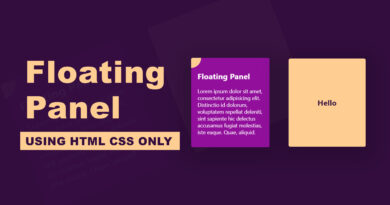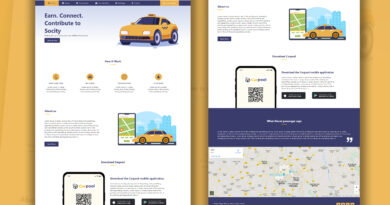How to Make a website Using HTML CSS
Understanding HTML, CSS, and the Basics of Website Creation
In the vast landscape of the internet, HTML and CSS stand as the foundational languages that shape the digital world we navigate daily. But what exactly are HTML and CSS, and how can they be harnessed to craft a website? In this blog, we’ll delve into the fundamentals of HTML, CSS, and explore the process of creating a website using these essential tools.
What is HTML?
HTML, or HyperText Markup Language, serves as the backbone of web pages, providing the structure and organization for content. It consists of a series of elements, each with its own purpose and function. These elements define headings, paragraphs, images, links, and more, allowing developers to create cohesive and accessible web pages.
At its core, HTML is a markup language comprised of tags enclosed in angle brackets (< >). For example, the <h1> tag denotes a top-level heading, while the <p> tag signifies a paragraph. By nesting these tags within one another, developers can construct intricate layouts and convey information effectively.
What is CSS?
While HTML establishes the structure of a web page, CSS, or Cascading Style Sheets, governs its visual presentation and layout. CSS enables developers to customize the appearance of HTML elements, specifying attributes such as colors, fonts, margins, and positioning.
By separating content from design, CSS promotes consistency and flexibility in web development. Developers can create reusable stylesheets containing sets of rules that dictate the look and feel of a website across multiple pages. This modularity simplifies maintenance and facilitates scalability as websites evolve and expand.
How to Make a Website Using HTML and CSS
Create A Responsive Coffee Shop Website Using HTML CSS & JAVASCRIPT Step by Step
Creating a website with HTML and CSS involves a straightforward process that can be broken down into several steps:
- Planning: Define the purpose and scope of your website, identifying key content and features to include.
- HTML Structure: Construct the basic layout of your web pages using HTML elements such as
<header>,<nav>,<main>,<section>, and<footer>. - Content Creation: Populate your HTML structure with textual and multimedia content, incorporating headings, paragraphs, images, videos, and other relevant elements.
- CSS Styling: Apply styles to your HTML elements using CSS, specifying attributes such as colors, fonts, margins, padding, and layout properties.
- Testing and Refinement: Preview your website in various web browsers and devices to ensure compatibility and responsiveness. Make adjustments to your HTML and CSS code as needed to achieve the desired appearance and functionality.
- Deployment: Once satisfied with your website, publish it online using a web hosting service, making it accessible to visitors worldwide.
Why Do We Need a Website?
In today’s digital age, a website serves as a crucial tool for individuals, businesses, organizations, and creators alike. Here are some reasons why having a website is essential:
- Online Presence: A website establishes your presence on the internet, allowing you to showcase your brand, portfolio, products, or services to a global audience.
- Accessibility: A website provides a centralized platform for users to access information, resources, and contact details at their convenience, enhancing accessibility and convenience.
- Credibility: A professionally designed website instills trust and credibility, demonstrating competence and legitimacy to potential customers, clients, employers, and collaborators.
- Marketing and Promotion: A website serves as a powerful marketing tool, enabling you to promote your offerings, engage with your audience, and attract new opportunities through search engine optimization (SEO), social media integration, and content marketing strategies.
- Communication and Engagement: A website facilitates communication and engagement with your audience, allowing you to interact through forms, comments, newsletters, and interactive features, fostering community and collaboration.
In conclusion, HTML and CSS form the building blocks of modern web development, empowering individuals and organizations to create visually stunning and functionally rich websites. By mastering these foundational languages and embracing the principles of effective web design, you can embark on a journey to craft compelling digital experiences that resonate with your audience and achieve your goals in the digital realm
Building Your First Website: A Beginner’s Guide to HTML and CSS
In today’s digital era, having a website is essential for individuals and businesses alike. Whether you’re showcasing your portfolio, promoting a product, or sharing your passion with the world, creating a website has never been more accessible. In this beginner’s guide, we’ll walk you through the process of building your first website using HTML and CSS.
Understanding HTML and CSS
Before diving into website creation, let’s briefly understand the role of HTML and CSS:
- HTML (HyperText Markup Language): HTML serves as the foundation of web pages, defining the structure and content. It uses tags to denote elements such as headings, paragraphs, images, and links.
- CSS (Cascading Style Sheets): CSS controls the visual presentation and layout of HTML elements. It allows you to customize colors, fonts, spacing, and more, enhancing the aesthetics and user experience of your website.
Step 1: Planning Your Website
Every successful website begins with a plan. Consider the purpose of your website, your target audience, and the content you want to showcase. Sketch out a rough layout to visualize the structure of your web pages.
Step 2: Setting Up Your Development Environment
To get started, you’ll need a text editor for writing code and a web browser for previewing your website. Popular text editors include Visual Studio Code, Sublime Text, and Atom. Choose one that suits your preferences and install it on your computer.
Step 3: Creating the HTML Structure
Open your text editor and create a new HTML file with a “.html” extension. Begin by defining the basic structure of your web page using HTML tags:
<code><!DOCTYPE html>
<html lang="en">
<head>
<meta charset="UTF-8">
<meta name="viewport" content="width=device-width, initial-scale=1.0">
<title>Your Website Title</title>
<link rel="stylesheet" href="styles.css">
</head>
<body>
<!-- Your content goes here -->
</body>
</html>
</code>Replace “Your Website Title” with the desired title for your website. The <link> tag links an external CSS file named “styles.css” to apply styles to your HTML content.
Step 4: Adding Content with HTML
Within the <body> tags, start adding content to your web page using HTML elements. For example:
<code><header>
<h1>Welcome to Your Website</h1>
</header>
<nav>
<ul>
<li><a href="#">Home</a></li>
<li><a href="#">About</a></li>
<li><a href="#">Services</a></li>
<li><a href="#">Contact</a></li>
</ul>
</nav>
<section>
<h2>About Us</h2>
<p>Lorem ipsum dolor sit amet, consectetur adipiscing elit....</p>
</section>
<footer>
<p>© 2024 Your Website. All rights reserved.</p>
</footer>
</code>Customize the content and structure according to your preferences and website goals.
Step 5: Styling with CSS
Create a new CSS file named “styles.css” in the same directory as your HTML file. Use CSS to style the HTML elements and make your website visually appealing:
<code>body {
font-family: Arial, sans-serif;
background-color: #f0f0f0;
color: #333;
}
header {
background-color: #333;
color: #fff;
padding: 20px;
text-align: center;
}
nav {
text-align: center;
}
/* Add more styles as needed */
</code>Experiment with different styles and properties to achieve the desired look for your website.
Step 6: Testing and Refining
Save your HTML and CSS files and open the HTML file in your web browser to preview your website. Make adjustments to your code as needed, refreshing the browser to see the changes in real-time.
How To Make A Resume design Using html CSS
Step 7: Publishing Your Website
Once you’re satisfied with your website, it’s time to share it with the world. You’ll need a domain name and web hosting to make your website accessible online. There are many hosting providers available, such as Bluehost, GoDaddy, or HostGator. Follow their instructions to upload your HTML and CSS files and publish your website.
Congratulations! You’ve successfully built your first website using HTML and CSS. With practice and experimentation, you can continue to refine your skills and create even more impressive web projects.




